The Iceman mummy, nicknamed Ötzi, was discovered in 1991 amidst sheets of melting ice on the Tisenjoch pass of the Similaun glacier in the Tyrolean Alps. He was found on the border between Italy and Austria, at an altitude of 3,200 m above sea level. He is a well-preserved male human corpse, dark in color, and dates to the early Copper Age, indicating he is more than 5,000 years old (ca. 3,250 yrs. cal BCE). His belongings, scattered around the body, included a bow and quiver with arrows, a complete copper-bladed axe, a flint dagger with a wicker sheath, two birch wood vessels clad with maple leaves, remnants of a backpack, a leather pouch with small objects, fur and leather garments, shoes, and other minor artifacts. When scientists realized the antiquity of the find, the media response was overwhelming and Ötzi captivated audiences far and wide.
Was Ötzi Attacked?
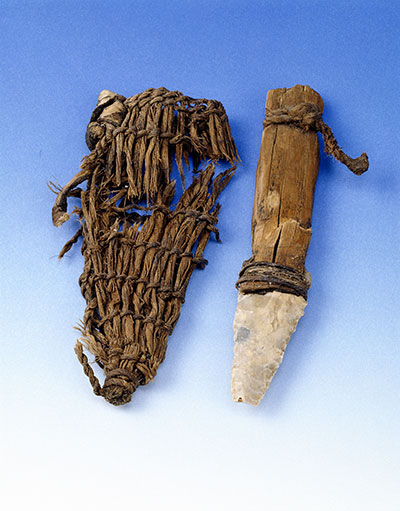
Both scholars and the general public gravitated to the so-called disaster theory in which Ötzi had climbed the slopes to the Tisenjoch. On the way or on the pass, he was mortally wounded in an armed attack. With an arrow deeply sunk in his left shoulder, he collapsed in solitude on the mountaintop, bleeding to death. His body would have been rapidly dried by a strong, warm wind, and was soon covered by frozen snow. No signs of scavenging activity were visible on the body, and all the equipment was left untouched.
Such a dramatic and even romantic reconstruction was simple to communicate and visualize. In the following years, after Ötzi was eventually put on exhibit at the Bozen Museum in Italy, the mummy became a popular tourist attraction and source of revenue. For these and other reasons, it was hard to question the original reconstruction of events surrounding the Iceman’s death. Even after careful excavations in 1992, the complete crime scene findspot was not reconstructed. After 20 years, a detailed topographic map of more than 400 artifacts found at the site and the analysis of their distribution with computer-aided simulations revealed that body and objects had moved downslope with the ice flow, but originally came from a spot measuring about 2 x 1 meters (a little more than 6 feet x 3 feet).
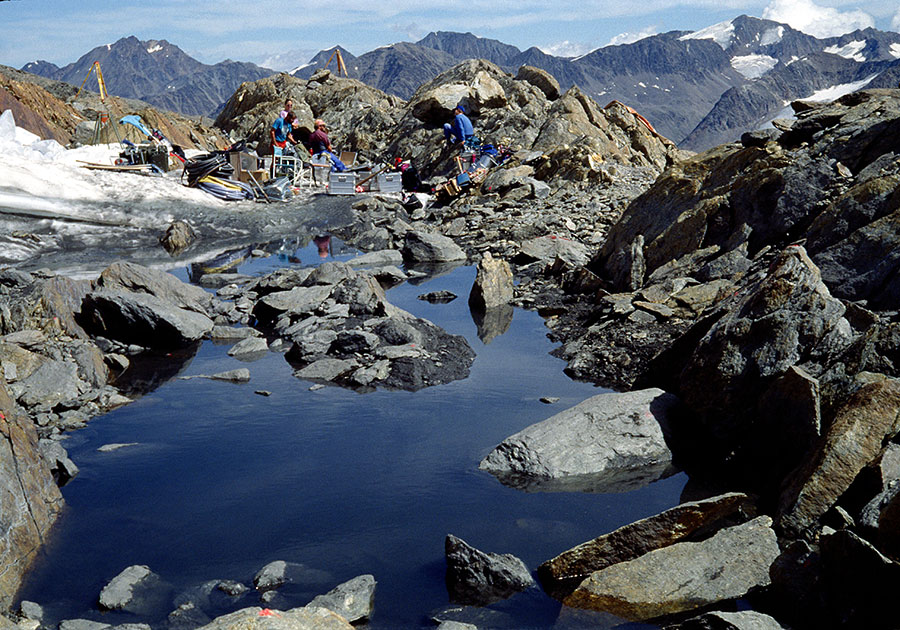
Was Ötzi Buried?
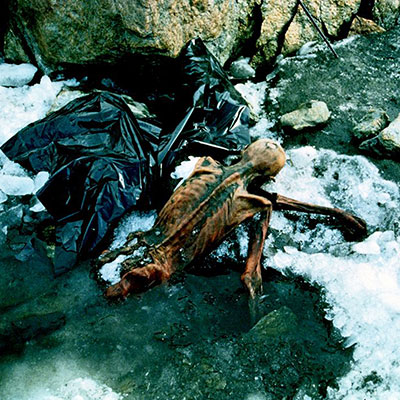
In 2010, a study was published suggesting that the mummy might owe its exceptional preservation to a proper burial and the equipment might not be a mountain survival kit, but rather what was needed for a yet more arduous trip—the voyage to the otherworld. Far from simply a casual killing, Ötzi opened a crucial window on the burial rituals and political strategies of a moment in European prehistory.
These findings paved the way for a comprehensive alternative interpretation. Pollen analysis proves that Ötzi died in early spring, when the mountains were probably still snow-covered; the body was likely left to rest for a few months in a controlled open-air environment, thus desiccating the corpse. When the pass became accessible, Ötzi may have been formally buried on the mountain peak to signal the political control of the tribe over its territory. Dug into snow and ice, the grave contents were partially dispersed by ice flows, until recent climatic fluctuation revealed the grave’s contents. This interpretation accounts for many anomalies, such as the unexplained mode of preservation of the body, unfinished arrows, shoes unsuitable for climbing, and the cumbersome equipment he supposedly carried. This new interpretation is informed by “social theory” and is opposed by Ötzi’s original research group, which still favors the “disaster theory.”
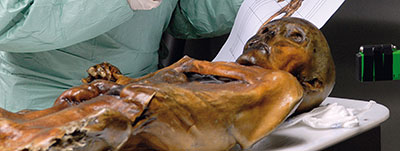
After thousands of samplings and high-tech analytical tests, Ötzi is the most intensively studied mummy in the history of archaeology. Almost universal agreement indicates that the mummy is not an artifact of human action, like Egyptian Dynastic mummies. The incredible preservation of Ötzi’s body has been and remains a crucial point since its discovery. The mummy is much better preserved than more recent bodies found in similar glaciers, underscoring its importance. Analysis of skin and underlying tissues revealed that Ötzi underwent rapid desiccation while exposed to circulating air, being encapsulated in ice only at a later time. Aeolian desiccation may be due to natural or intentional processes. Material evidence is compatible with alternative theories: natural desiccation at the findspot (“disaster theory”) or a sort of funerary treatment followed by burial at high altitude (“social theory”). Today, at Bozen, the body of Ötzi is visible through the glass of a special freezing chamber. To keep him publicly viewable while minimizing risk of damage and decay is a demanding and costly challenge. In both technical and economical terms, public presentation and conservation are conflicting needs; the present compromise is required due to Ötzi’s rarity and extreme popularity.
The Copper Age on the Similaun Glacier
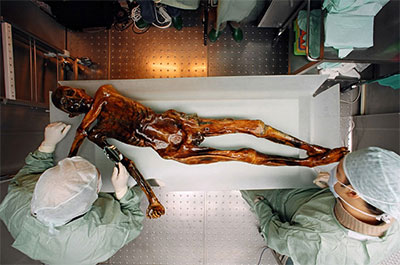
Beyond the details of the mummy’s preservation and burial, Ötzi’s discovery sheds new and unexpected light on Copper Age societies. Healed injuries, such as a hand dagger wound and the fatal arrow shot, possibly coupled with a blow to the head, suggest regular warfare and imply the use of different weapons. Analysis of the gut pollen content suggests that Ötzi had moved at different altitudes, which fits well with a model of squad-raiding warfare.
Ötzi the Iceman’s meals demonstrate a fully agrarian and pastoral lifeway, but one that was still deeply economically and symbolically involved with the wild, probably sacred world of the mountains. Daily village life is suggested by ingested cereals, possible cheese residues, and pottery grains mixed in the food, as well as by goat and cattle skin in the associated garments. However, the last meat he ate came from hunted deer and ibex, wild animals that had contributed to other parts of his dress. He also wore a cap likely made of bearskin.
Ötzi also had the marks of a leader of his time, with prestigious weapons (dagger, axe, bow, and arrows), tools, and an ornament (a marble bead). The stone and copper components of these objects precisely match those found in the contemporary graves of the floodplain, but most striking are the preserved, highly refined garments. The care with which various animal skins of contrasting colors were selected and matched and the elaboration and coordination of the attire point to a complex encoding of role and personal identity. Ötzi’s coat and belt match the highly symbolic imagery of the monumental stone stelae that, in the later Alpine Copper Age, feature armed heroic ancestors or deities. In this light, while Ötzi may have been a revered tribal chief, later stelae celebrate impersonal, perhaps sacred, ancestral identities. Growing abstraction of power roles might have been a side-effect of the evolution of increasingly formalized political institutions.
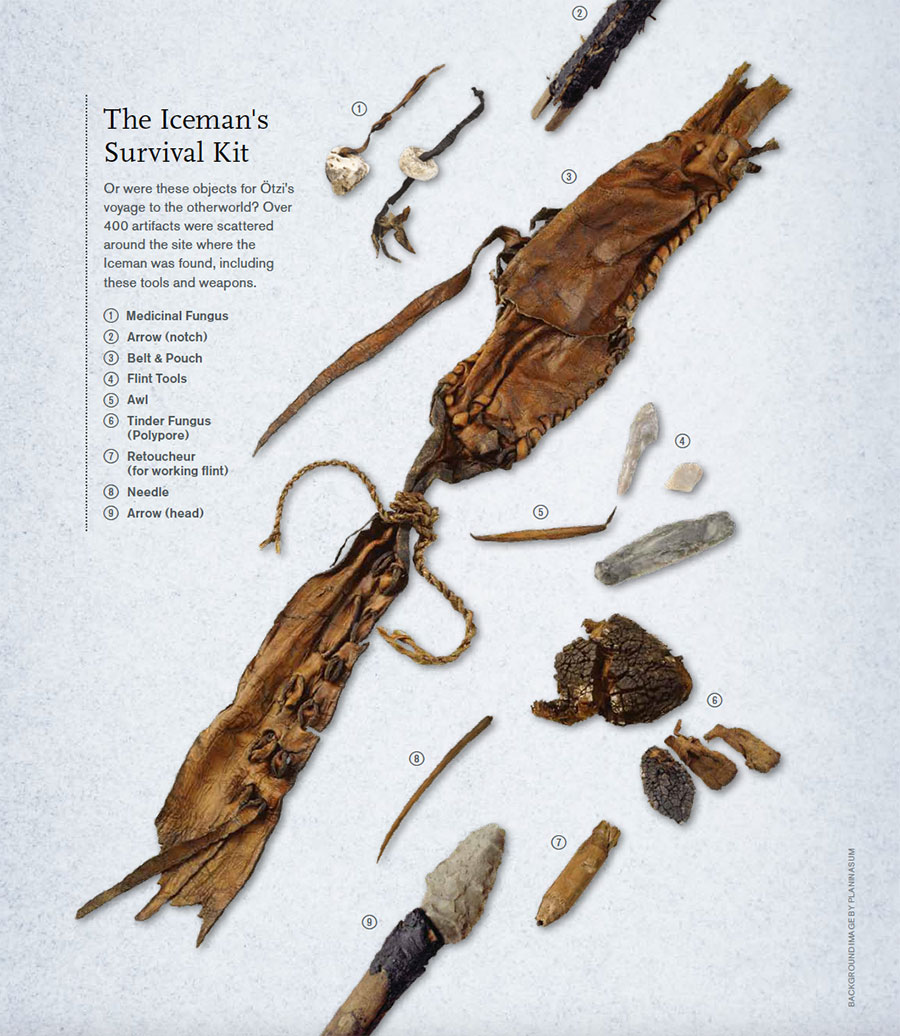
The Iceman’s Survival Kit
Or were these objects for Ötzi’s voyage to the otherworld? Over 400 artifacts were scattered around the site where the Iceman was found, including these tools and weapons.
- Medicinal Fungus
- Arrow (notch)
- Belt & Pouch
- Flint Tools
- Awl
- Tinder Fungus (Polypore)
- Retoucheur (for working flint)
- Needle
- Arrow (head)
Other Icemen?
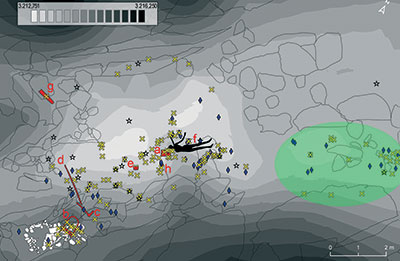
Blue diamonds: heavier items such as pelt and leather. Yellow “x”s: lighter items such as grass and hair-like items. Black empty stars: intrusive items. Light green area: items displaced during excavation. White boulders and stones indicate the platform, the proposed grave location.
Objects designated by red letters: (A) grass mat; (B) backpack frame; (C) axe; (D) bow; (E) birch bark vessel; (F) dagger; (G)quiver; and (H) cap. First published in Antiquity 84.325 (2010): 681-692.
Was Ötzi an isolated case? Although no evidence exists for similarly spectacular discoveries, significant artifacts dating to the same period surfaced at similar highaltitude Alpine locations. In some cases, such finds (axes, daggers, arrow heads) are alternatively explained as casual losses by travelers and shepherds, or as parts of buried caches. However, at least one other high-altitude Alpine pass, the Schnidejoch, which has a similar topographic setting and gradual glacial melting, has revealed clothing fragments, a wooden bow, a quiver and arrows, and shoe fragments. This material has been radiocarbon-dated to between the early 3rd millennium and the 2nd millennium BCE. Although no bodies have been recovered, such finds might come from collapsed graves similar to that of Ötzi.
Even Alpine folklore suggests that Copper and Bronze Age bodies and burials could be preserved by ice, only to come slowly to light with the transition to a milder climate. The following legend was recorded in 1862 by the historian Luigi Cibrario on a high Piedmont valley: it happens that the glaciers that stretch between the mountains cover a crowd of sinners, both male and female, to whom the embrace of God is precluded until they have destroyed the huge mass of ice with the needles that they all hold. It is likely that the legend reflects the sighting of one or more high-altitude Bronze Age burials in which the dead, according to the funerary habits of the time, wore long copper pins. Emerging from ice like Ötzi, this could very well match the portrayal of sinners in old, traditional outdoor shrines of the same region, as black-skinned, almost skeletal figures.
Acknowledgments
The authors are very grateful to Francesco Rubat Borel for telling us about the revealing legend of the sinners with needles mentioned at the end of this article.
Massimo Vidale, Ph.D. (University of Padova), Luca Bondioli, Ph.D. (National Museum of Prehistory and Ethnography Luigi Pigorini), David W. Frayer, Ph.D. (University of Kansas), Marina Gallinaro, Ph.D. (Università degli Studi di Sassari), and Alessandro Vanzetti, Ph.D. (Sapienza University of Rome) contributed to this study.
For Further Reading
Fowler, B. Iceman: Uncovering the Life and Times of a Prehistoric Man Found in an Alpine Glacier. New York: Random House, 2000.Grosjean, M., Suter, P.J., Trachsel, M., and Wanne, H. “Iceborne Prehistoric Finds in the Swiss Alps Reflect Holocene Glacier Fluctuations.” Journal of Quaternary Science 22 (2007): 203-207.
Oeggl, K., Kofler, W., Schimidl, A., Dickson, J.H., and Egarter Vigl, E. “The Reconstruction of the Last Itinerary of Ötzi, the Neolithic Iceman, by Pollen Analyses from Sequentially Sampled Gut Extracts.” Quaternary Science Reviews 26 (2007): 853-861.
Pernter, P., Gostner, P., Egarter Vigl, E., and Rühli, F.J. “Radiologic Proof for the Iceman’s Cause of Death (ca. 5300 BP).” Journal of Archaeological Science 34 (2007): 1784–1786.
Samadelli, M., ed. The Chalcolithic Mummy: In Search of Immortality. Volume 3. Schriften des Südtiroler Archäologiemuseums, Bd. 4. Wien Bozen, Folio Verlag, 2006.
Samadelli, M., Roselli, G., Fernicola, V., Moroder, L. and Zink, A.R. “Theoretical Aspects of Physical-chemical Parameters for the Correct Conservation of Mummies on Display in Museums and Preserved in Storage Rooms.” Journal of Cultural Heritage 14 (2013): 480-484.
Schriften des Südtiroler Archäologiemuseums, Bd. 4. Wien-Bozen, Folio Verlag, 2006.
Vanzetti, A., Vidale, M., Gallinaro, M., Frayer, D.W., and Bondioli, L. (2010) “The Iceman as a Burial.” Antiquity 84 (2010): 681–692.
